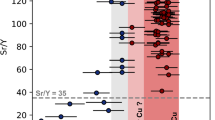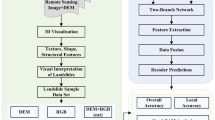Abstract
Convolutional neural network (CNN) has demonstrated promising performance in classification and prediction in various fields. In this study, a CNN is used for mineral prospectivity mapping (MPM) in the southwestern Fujian Province, China. Two limitations of applying CNNs in MPM are addressed: insufficient labeled samples and difficulty of applying CNNs to geological prospecting big data for MPM, which are characterized by massive size, multiple sources, multiple types, multi-temporality, multiple scales, non-stationarity, and heterogeneity. The random-drop data augmentation method, which repeatedly takes dropouts from data, is adopted in this study for generating sufficient training samples. Various experiments are conducted to determine a suitable CNN architecture for MPM. The mapped areas obtained by the constructed CNN are strongly spatially correlated with the locations of known mineralization, and most of the known Fe polymetallic deposits are located in areas with high probabilities. Our findings indicate that such a random-drop data augmentation method is suitable and effective for constructing training datasets to predict the locations of rare geological events. Additionally, CNN appears as a promising tool for integrating multi-source geoscience data, thereby supporting further mineral exploration.








Similar content being viewed by others
References
Abedi, M., Norouzi, G. H., & Bahroudi, A. (2012). Support vector machine for multi-classification of mineral prospectivity areas. Computers & Geosciences, 46, 272–283.
Agterberg, F. P., & Bonham-Carter, G. F. (1999). Logistic regression and weights of evidence modeling in mineral exploration. In Proceedings of the 28th international symposium on applications of computer in the mineral industry (APCOM), Golden, Colorado (pp. 483–490).
Agterberg, F. P., Bonham-Carter, G. F., & Wright, D. F. (1990). Statistical pattern integration for mineral exploration. In Computer applications in resource estimation (pp. 1–21).
An, P., Moon, W. M., & Rencz, A. (1991). Application of fuzzy set theory for integration of geological, geophysical and remote sensing data. Canadian Journal of Exploration Geophysics, 27(1), 1–11.
Bonham-Carter, G. F. (1989). Weights of evidence modeling: a new approach to mapping mineral potential. Statistical Applications in the Earth Sciences, 1, 171–183.
Brown, W. M., Gedeon, T. D., Groves, D. I., & Barnes, R. G. (2012). Artificial neural networks: A new method for mineral prospectivity mapping. Australian Journal of Earth Sciences, 47, 757–770.
Carranza, E. J. M. (2004). Weights of evidence modeling of mineral potential: a case study using small number of prospects, Abra, Philippines. Natural Resources Research, 13, 173–187.
Carranza, E. J. M., & Laborte, A. G. (2015a). Data-driven predictive mapping of gold prospectivity, Baguio district, Philippines: Application of Random Forests algorithm. Ore Geology Reviews, 71, 77–787.
Carranza, E. J. M., & Laborte, A. G. (2015b). Random forest predictive modeling of mineral prospectivity with small number of prospects and data with missing values in Abra (Philippines). Computers & Geosciences, 74, 60–70.
Carranza, E. J. M., & Laborte, A. G. (2016). Data-driven predictive modeling of mineral prospectivity using Random Forests: a case study in Catanduanes Island (Philippines). Natural Resources Research, 25, 35–50.
Chen, C., Dai, H., Liu, Y., & He, B. (2011). Mineral prospectivity mapping integrating multi-source geology spatial data sets and logistic regression modelling. In Proceedings 2011 IEEE international conference on spatial data mining and geographical knowledge services (pp. 214–217).
Cheng, Q. (2007). Mapping singularities with stream sediment geochemical data for prediction of undiscovered mineral deposits in Gejiu, Yunnan Province, China. Ore Geology Reviews, 32, 314–324.
Cheng, Q. (2012). Singularity theory and methods for mapping geochemical anomalies caused by buried sources and for predicting undiscovered mineral deposits in covered areas. Journal of Geochemical Exploration, 122, 55–70.
Cheng, Q., & Agterberg, F. P. (1999). Fuzzy weights of evidence method and its application in mineral potential mapping. Natural Resources Research, 8, 27–35.
Deng, J., Dong, W., Socher, R., Li, L., Li, K., & Li, F. (2009). Imagenet: A large-scale hierarchical image database. In 2009 IEEE conference on computer vision and pattern recognition (pp. 248–255).
Dieleman, S., Willett, K. W., & Dambre, J. (2015). Rotation-invariant convolutional neural networks for galaxy morphology prediction. Monthly Notices of the Royal Astronomical Society, 450(2), 1441–1459.
Guerra Prado, E. M., de Souza Filho, C. R., Carranza, E. J. M., & Motta, J. G. (2020). Modeling of Cu-Au Prospectivity in the Carajás mineral province (Brazil) through Machine Learning: Dealing with Imbalanced Training Data. Ore Geology Reviews, 124, 103611.
Guo, H., Wang, L., & Liang, D. (2016). Big earth data from space: a new engine for earth science. Science Bulletin, 61(7), 505–513.
Hinton, G., Deng, L., Yu, D., Dahl, G. E., Mohamed, A. R., Jaitly, N., et al. (2012). Deep neural networks for acoustic modeling in speech recognition: The shared views of four research groups. IEEE Signal Processing Magazine, 29(6), 82–97.
Keskar, N. S., Mudigere, D., Nocedal, J., Smelyanskiy, M., & Tang, P. T. P. (2016). On large-batch training for deep learning: Generalization gap and sharp minima. arXiv preprint arXiv:1609.04836.
Kingma, D. P., & Ba, J. (2014). Adam: A method for stochastic optimization. arXiv preprint arXiv:1412.6980.
Krizhevsky, A., &Hinton, G. E. (2009). Learning multiple layers of features from tiny images. Vol. 1. No. 4. Technical report, University of Toronto, 2009.
Krizhevsky, A., Sutskever, I., & Hinton, G. E. (2012). Imagenet classification with deep convolutional neural networks. In Advances in neural information processing systems (pp. 1097–1105).
LeCun, Y., Bottou, L., Bengio, Y., & Haffner, P. (1998). Gradient-based learning applied to document recognition. Proceedings of the IEEE, 86, 2278–2324.
Li, S., Chen, J., & Xiang, J. (2020). Applications of deep convolutional neural networks in prospecting prediction based on two-dimensional geological big data. Neural Computing and Applications, 32, 2037–2053.
Lin, D. (2011). Research on late paleozoic-triassic tectonic evolution and metallogenetic regularities of iron-polymetallic deposits in the Southwestern Fujian Province. Beijing: China University of Geoscience. (In Chinese with English abstract).
Mao, J., Tao, K., Xie, F., Zheng, X., & Chen, S. (2001). Rock-forming and ore-forming processes and tectonic environments in southwest Fujian. Acta Petrologica Et Mineralogica, 1, 329–336. (In Chinese with English abstract).
McKay, G., & Harris, J. R. (2016). Comparison of the data-driven random forests model and a knowledge-driven method for mineral prospectivity mapping: A case study for gold deposits around the Huritz Group and Nueltin Suite, Nunavut, Canada. Natural Resources Research, 25(2), 125–143.
Meinert, L. D. (1992). Skarns and skarn deposits. Geoscience Canada, 19(4), 192–195.
Nair, V., & Hinton, G. E. (2010). Rectified linear units improve restricted Boltzmann machines. In Proceedings of the 27th international conference on machine learning (ICML-10) (pp. 807–814).
Nykänen, V., Lahti, I., Niiranen, T., & Korhonen, K. (2015). Receiver operating characteristics (ROC) as validation tool for prospectivity models—a magmatic Ni–Cu case study from the Central Lapland Greenstone Belt, northern Finland. Ore Geology Reviews, 71, 853–860.
Porwal, A., Carranza, E. J. M., & Hale, M. (2006a). A hybrid fuzzy weights-of-evidence model for mineral potential mapping. Natural Resources Research, 15(1), 1–14.
Porwal, A., Carranza, E. J. M., & Hale, M. (2006b). Bayesian network classifiers for mineral potential mapping. Computers & Geosciences, 32(1), 1–16.
Simard, P. Y., Steinkraus, D., & Platt, J. C. (2003). Best practices for convolutional neural networks applied to visual document analysis. International Conference on Document Analysis and Recognition, 2, 958–962.
Simonyan, K., &Zisserman, A. (2014). Very deep convolutional networks for large-scale image recognition. arXiv preprint arXiv:1409.1556.
Sun, T., Li, H., Wu, K., Chen, F., Zhu, Z., & Hu, Z. (2020). Data-driven predictive modelling of mineral prospectivity using machine learning and deep learning methods: A case study from Southern Jiangxi Province. China. Minerals, 10(2), 102.
Wang, J., Zuo, R., & Xiong, Y. (2020). Mapping mineral prospectivity via semi–supervised random forest. Natural Resources Research, 29, 189–202.
Xie, X., Mu, X., & Ren, T. (1997). Geochemical mapping in China. Journal of Geochemical Exploration, 60(1), 99–113.
Xiong, Y., & Zuo, R. (2017). Effects of misclassification costs on mapping mineral prospectivity. Ore Geology Reviews, 82, 1–9.
Xiong, Y., & Zuo, R. (2018). GIS-based rare events logistic regression for mineral prospectivity mapping. Computers & Geosciences, 111, 18–25.
Xiong, Y., & Zuo, R. (2020). Recognizing multivariate geochemical anomalies for mineral exploration by combining deep learning and one-class support vector machine. Computers & Geosciences, 140, 104484.
Zhang, Z., Cheng, Q., Yang, J., & Hu, X. (2018a). Characterization and origin of granites from the Luoyang Fe deposit, southwestern Fujian Province, South China. Journal of Geochemical Exploration, 184, 119–135.
Zhang, D., Ren, N., & Hou, X. (2018b). An improved logistic regression model based on a spatially weighted technique (ILRBSWT v1. 0) and its application to mineral prospectivity mapping. Geoscientific Model Development, 11(6), 23–25.
Zhang, Z., & Zuo, R. (2015). Tectonic Evolution of southwestern Fujian Province and spatial-temporal distribution regularity of mineral deposits. Acta Petrologica Sinica, 1, 217–229. (In Chinese with English abstract).
Zhang, Z., Zuo, R., & Xiong, Y. (2016). A comparative study of fuzzy weights of evidence and random forests for mapping mineral prospectivity for skarn-type Fe deposits in the southwestern Fujian metallogenic belt, China. Science China Earth Sciences, 59(3), 556–572.
Zhao, Y., Tan, H., & Sun, J. (1982). Characteristics of the skarn zoning of the makeng and yengshan iron ore deposits in Fujian and their relationship with the mineralization zoning. ACTA Petrologica and Mineralogica et. Analytica, 1, 11–22. (In Chinese with English abstract).
Zhao, Y., Tan, H., Xu, Z., Yuan, R., Zheng, R., & Lin, F. (1980). Geological conditions of the formation of calcific-skarn iron deposits in southwestern Fujian and characteristics of their alternation and mineralization. Acta Geoscientica Sinica, 1, 22–48. (In Chinese with English abstract).
Zuo, R. (2017). Machine learning of mineralization-related geochemical anomalies: A review of potential methods. Natural Resources Research, 26, 457–464.
Zuo, R. (2020). Geodata science-based mineral prospectivity mapping: A review. Natural Resources Research. https://doi.org/10.1007/s11053-020-09700-9.
Zuo, R., & Carranza, E. J. M. (2011). Support vector machine: A tool for mapping mineral prospectivity. Computers & Geosciences, 37(12), 1967–1975.
Zuo, R., Peng, Y., Li, T., & Xiong, Y. (2020). Challenges of geological prospecting big data mining and integration using deep learning algorithms. Earth Science. https://doi.org/10.3799/dqkx.2020.111. (In Chinese with English abstract).
Zuo, R., & Wang, Z. (2020). Effects of random negative training samples on mineral prospectivity mapping. Natural Resources Research. https://doi.org/10.1007/s11053-020-09668-6.
Zuo, R., & Xiong, Y. (2018). Big data analytics of identifying geochemical anomalies supported by machine learning methods. Natural Resources Research, 27, 5–13.
Zuo, R., & Xiong, Y. (2020). Geodata science and geochemical mapping. Journal of Geochemical Exploration, 209, 106431.
Zuo, R., Xiong, Y., Wang, J., & Carranza, E. J. M. (2019). Deep learning and its application in geochemical mapping. Earth-Science Reviews, 192, 1–14.
Zuo, R., Zhang, Z., Zhang, D., Carranza, E. J. M., & Wang, H. (2015). Evaluation of uncertainty in mineral prospectivity mapping due to missing evidence: a case study with skarn-type Fe deposits in Southwestern Fujian Province, China. Ore Geology Reviews, 71, 502–515.
Acknowledgments
This work was supported by the National Natural Science Foundation of China (No. 41772344). We thank two reviewers’ comments and suggestions, which helped us to improve this study.
Author information
Authors and Affiliations
Corresponding author
Rights and permissions
About this article
Cite this article
Li, T., Zuo, R., Xiong, Y. et al. Random-Drop Data Augmentation of Deep Convolutional Neural Network for Mineral Prospectivity Mapping. Nat Resour Res 30, 27–38 (2021). https://doi.org/10.1007/s11053-020-09742-z
Received:
Accepted:
Published:
Issue Date:
DOI: https://doi.org/10.1007/s11053-020-09742-z




